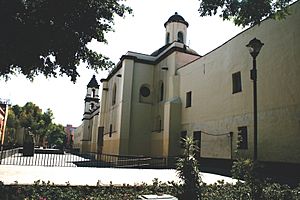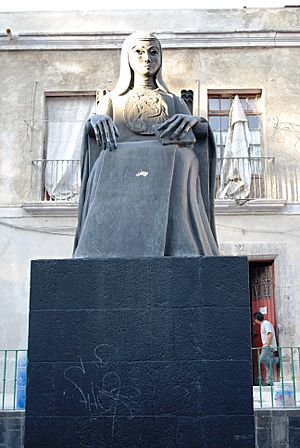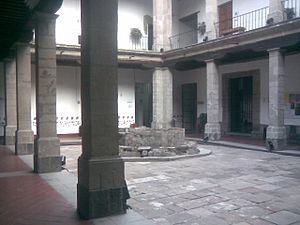University of the Cloister of Sor Juana facts for kids
|
Universidad del Claustro de Sor Juana
|
|
 |
|
| Motto |
Saber para valorar. Valorar para elegir.
|
|---|---|
|
Motto in English
|
To know in order to value. To value in order to choose. |
| Type | Private |
| Established | 1979 |
| Rector | Carmen Beatriz López Portillo |
| Undergraduates | 1,582 |
| Postgraduates | 39 |
| Location |
Mexico City
,
Mexico
|
| Campus | Former cloister of Sor Juana de la Cruz |
| Website | Official website: http://www.ucsj.edu.mx/ |
The University of the Cloister of Sor Juana (Spanish: Universidad del Claustro de Sor Juana) is a private university in Mexico City. It is located in an old building that used to be the San Jerónimo Convent. This convent is famous because Sor Juana Inés de la Cruz, a very important writer, lived and wrote many of her works there for over 25 years.
After the convent closed in the 1800s, the large building was split up. It was used for different things, even a big dance hall in the mid-1900s. In the 1970s, the government took over the building to protect it. They started to fix it up. In 1979, the University of the Cloister of Sor Juana was started in this historic place. Today, the university takes care of the building. It offers college degrees and master's degrees, mostly in subjects like history, literature, and art. The university also helps with many cultural and educational events in the city's historic center.
Contents
The Historic Cloister Building
The cloister, which is like a quiet courtyard area, was started in 1585. It was founded by Isabel de Barrios. The convent was created by joining two private homes. Over time, it grew bigger and bigger. It became the home for nuns of the Saint Jerome order.
The church building was finished in 1623. It was built in a style called Renaissance, which was popular at the time. The church tower was added in 1665. Even though it was built during the Baroque period, the tower is quite simple. The convent was first named after Saint Paula.
This convent is best known as the home of Sor Juana Inés de la Cruz. She lived there for more than 27 years. Sor Juana, sometimes called the "Tenth Muse" of Mexico, wrote most of her famous works while living here.
In 1867, the convent was closed because of new laws. The building was then used as a military camp and hospital. Later, the main courtyard was used for different groups. By the early 1900s, parts of the building were given to private owners. The church part became government property and was declared a national monument. One well-known business that operated here was the Smyrna Dancing Club in the mid-1900s.
In 1975, a group interested in Sor Juana asked the president to protect the building. From 1976 to 1982, experts like archaeologists and historians explored and restored the complex. They found many items from the nuns' daily lives, like old tiles and water systems. They also found tombs. Today, the university is in charge of keeping the building safe. It is considered a "National Heritage Site" and is even shown on the back of a 200 peso bill.
In the mid-2000s, there was a disagreement about who owned the Church of San Jeronimo. The university fought to keep it as an educational and cultural place. They won in court. The university can keep the entire property as long as it remains a school and cultural center.
Learning at the University
The Universidad del Claustro de Sor Juana opened in 1979. It first offered a degree in "Human Sciences." Today, the university offers eight different bachelor's degrees. These include Art, Communication, Culture Studies, Philosophy, Gastronomy (the art of food), Humanities, Creative Writing, and Psychology. It also has master's degrees in Colonial Mexican Culture and Food Business. Most students find jobs in their chosen fields after graduating. The gastronomy program is especially popular. The life and writings of Sor Juana are a big part of what the university teaches and how it sees itself. The inside of the building mixes old colonial styles with modern designs.
In 2003, the university grew by adding the nearby Regina campus. This campus was once part of another old convent. It has beautiful buildings designed by Manuel Tolsá.
The Library and Special Centers
The university's library has a special section called the Sor Juana Inés de la Cruz Documentation Center. This center aims to collect all important writings about Sor Juana and her life. It has many old books and magazines about her. The main library also has many first edition books, most of which were donated.
In 2007, the Pier Paolo Pasolina Peace Center was opened. This center helps people connect their personal memories with shared history to find ways to create peace.
Art and Culture at the University
Many areas in the university building are used for art and cultural exhibits. The university is home to the Luis Márquez Romay Museum of Mexican Attire. This museum shows a large collection of traditional Mexican clothing. Many pieces were given by Carmen Romano, who was Mexico's First Lady from 1976 to 1982. The museum also hosts temporary exhibits, like art shows.
In 2007, there was an exhibit called "Crowned Nuns." It showed items related to the special ceremony when nuns took their vows. This included the large crowns they wore during the colonial period. Concerts and art shows are also held in the former Church of San Jerónimo. The school also has a collection of musical instruments, including four old pianos. These are used for concerts.
Community Programs
San Jeronimo Street, which is in front of the university, is now a pedestrian-only area. It is being made into a "cultural corridor" as part of the university's efforts to connect with the community. The school also has other programs, like helping people in the city center learn to read and write. They also offer free counseling for families and people dealing with addiction. The university says these actions help to make the historic center a better place.
According to a survey in 2009, students at Sor Juana are big coffee drinkers. This might be because the campus is surrounded by many nice cafes. These cafes often have cultural events like films and poetry readings.
Student Traditions and Activities
Every year, university students create a huge "ofrenda," or altar for the dead, for the Day of the Dead celebrations. This happens in late October and early November. Students, teachers, artists, and neighbors from the historic center all work together on it. In 2007, the altar's theme was "Sor Juana and time." It included an hourglass and thousands of marigold garlands. A smaller altar was also made to honor Frida Kahlo. This tradition has been happening for over twenty years.
The Chorus of the Universidad del Claustro de Sor Juana performs under different guest directors. The chorus sings older songs that are not often performed today. It is made up of students from various study areas and started in 2005.
University Partnerships
The university works with other schools and cultural groups. It has a partnership with UNAM, another big university, for teaching, research, and cultural activities. This allows students from both universities to take classes at either place. They also host joint academic events.
The university also worked with the Historic Center Foundation to publish a guide to restaurants and eateries in Mexico City's oldest neighborhoods. It's called "Guide to Eating Well in the Historic Center."
The school helps organize the yearly "Festival de México" in the historic center. They hold talks and a cooking contest about the history of Mexican food. This event helps to recognize and keep Mexican food traditions alive. Participants not only cook a dish but also research its history.
Outside of Mexico City, the university organized a "poetry slam" event in 2009 at the Guadalajara International Book Fair. People performed their own poems, and poets and rappers judged them. The event was called "To the Beat of Poetry." The school sponsored it to show that poetry is for everyone.
See also
 In Spanish: Universidad del Claustro de Sor Juana para niños
In Spanish: Universidad del Claustro de Sor Juana para niños






